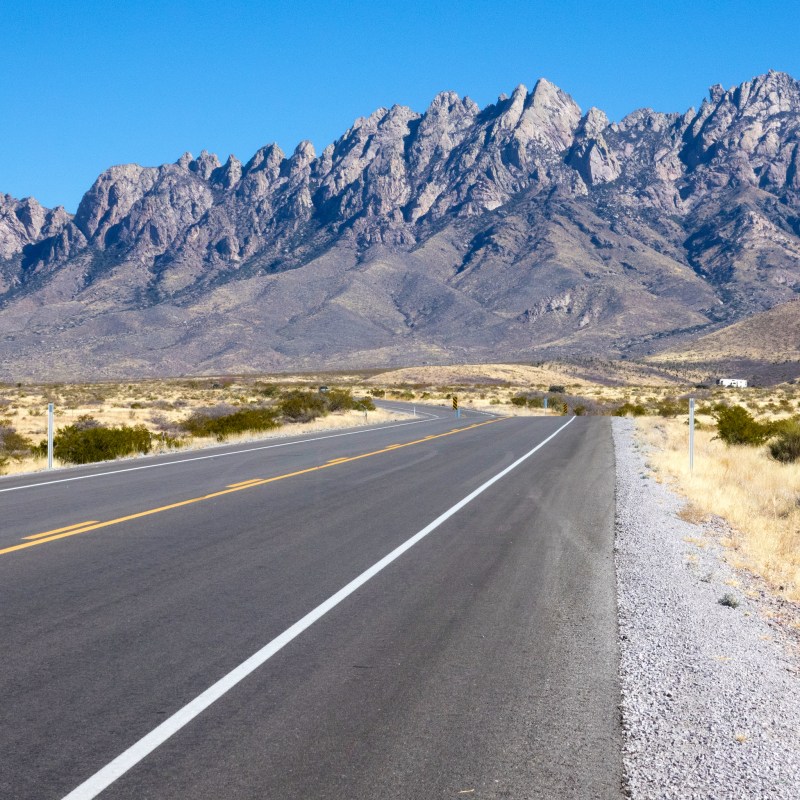
From the world’s largest hot air balloon festival in Albuquerque to the state capital of Santa Fe to the art community of Taos, most people who visit the Land of Enchantment spend their time 200 to 350 miles north of New Mexico’s second-largest city.
Videos by TravelAwaits
Built on the rich soil along the Rio Grande and surrounded by the craggy Organ Mountains, Las Cruces is the starting point for this New Mexico road trip that winds northeast through some of the most beautiful (and least traveled) areas of New Mexico.
Because my parents live in Las Cruces and this is part of my road trip route to visit them, I’m excited to drive it at any time of the year. But my favorite time to visit is the spring, when I can escape the bone-chilling cold of the Midwest while reveling in the beautiful views of the desert in bloom.
This road trip is also pretty during the winter months. In fact, the first time I drove through the Sierra Blanca, the mountains were blanketed in a fresh layer of unspoiled snow. Brilliant rays of sunshine streaming through the fir trees made the snow sparkle, and it felt like I was driving through a winter wonderland.

Las Cruces
The expansion of the railroad and the construction of the Interstate Highway System profoundly affected the towns that anchor this road trip. Las Cruces was selected as the location for the area’s train station in the mid 1800s, and the iron beams staked to the Chihuahuan Desert rerouted activity from the bustling town of Mesilla to the City of Crosses.
So, in recognition of its contributions to the history of the area, visit Mesilla, located just a few miles southwest of downtown Las Cruces. The historic plaza, anchored by the Basilica of San Albino, is now surrounded by local shops and restaurants. As you wander, look for informational plaques that explain Mesilla’s history posted outside many of the buildings. After shopping for silver jewelry, handmade items, and local food souvenirs, enjoy a bite to eat and a margarita at La Posta de Mesilla, a local gem that has served authentic New Mexican cuisine since World War II.

With its abundant sunshine and temperate year-round weather, Las Cruces is a great place to spend time outside. Hike “A” Mountain (named after the New Mexico State Aggies) for phenomenal views of Las Cruces. Visit the Dripping Springs Natural Area, where you can explore the haunting ruins of a sanatorium for patients with tuberculosis. Or enjoy a casual afternoon and a picnic at Veterans Memorial Park, Apodaca Park, or Young Park.
Once you’ve had your fill of everything green chile and have crossed your must-see experiences off your Las Cruces bucket list, jump in the car and head east. But before you go, check for road closures along U.S. Route 70 by visiting NMRoads or calling (575) 678-1178. Why? Because when a test is underway at the White Sands Missile Range, the highway is often closed to traffic for up to an hour, and nothing puts a damper on a road trip like being parked on a highway.
Pro Tip: About 30 minutes east of Las Cruces, make a quick stop at the Space Murals Museum and Gift Shop in the small town of Organ. As is true of most water towers in Las Cruces, the standard-issue metal tank is covered with bright, thematic murals. You can find a complete list of the Las Cruces water tank murals, including a map, here.

White Sands
To Southern New Mexicans, “White Sands” can mean one of two things: the missile range or the national monument. On this road trip, we’ll visit both!
About 30 minutes east of Las Cruces, on the other side of the Organ Mountains, is the White Sands Missile Range Museum. Step inside to learn more about Southern New Mexico’s contributions to the development of the atomic bomb used to end World War II and the present-day testing facility. In the missile park outside the museum, visitors can examine a variety of rockets, missiles, and aircraft.

Another half hour northeast, stop at White Sands National Park to take in the cool, powdery white sand of one of the world’s biggest gypsum sand dune fields. Tour the park by car along Dunes Drive or explore on foot by walking along the Interdune Boardwalk or sinking your feet into the shifting sands of a backcountry hiking trail.
Whether you choose to explore from the comfort of your car or on foot, don’t leave the White Sands Visitor Center without plenty of water for everyone in your party. Potable water isn’t available elsewhere in the park, and the arid high desert can be stealthily dehydrating.

Alamogordo
Continuing northeast, Alamogordo is the first town after White Sands, making it the perfect place to fuel up both your car and your stomach. If you’re craving a cup of coffee and breakfast fare, head to the Waffle & Pancake Shoppe. For street tacos, enchiladas, and other delights topped with fresh New Mexico chile, enjoy lunch or dinner at Rizo’s Restaurant. Or if you want to grab sandwiches and sides for a picnic, check out the Brown Bag Deli.
If you didn’t get your fill of space history at the water tank mural pit stop and missile range museum, then visit the New Mexico Museum of Space History in Alamogordo. Inside the multistory mirrored cube, you can learn about rockets, what it’s like to live in space, and more.
For a change of pace from outer space, head to the Alameda Park Zoo. This small but well-maintained park does an outstanding job of keeping natural enclosures and educating visitors about the animals.
Before heading for the forests and mountains that await, take a free tour of Eagle Ranch. Established by a retired Air Force officer and his wife, this working pistachio farm and vineyard produces delicious nuts and award-winning wines that can’t be missed.

Lincoln National Forest
Covering more than a million acres of land, the Lincoln National Forest lies directly east of Alamogordo. The forest elevation ranges from 4,000 to 11,500 feet above sea level, and visitors can experience five different climates, from the cactus-filled Chihuahuan Desert to a fir-lined subalpine desert.
While the barrel-chested, denim-wearing cartoon version of Smokey Bear is widely recognized across the United States, few know about the real-life inspiration for the U.S. Forest Service’s blaze beacon. In 1950, a badly burned bear cub was rescued from a tree in the Lincoln National Forest’s Capitan Mountains region. After being nursed back to health, Smokey spent the remainder of his life at the National Zoo in Washington, D.C., where he was the inspiration for a fire prevention and safety program still in effect today.
Pro Tip: To explore the Lincoln National Forest by car, check out these scenic drives.

Tularosa
Throughout New Mexico, stick-figure characters and simple illustrations of native animals serve as reminders of the indigenous people who inhabited this land long before the Spanish conquistadors and European settlers arrived. Stop at Three Rivers Petroglyph Site near Tularosa to admire thousands of examples of prehistoric Jornada Mogollon art.

Ruidoso
Arcing eastward along the Sierra Blanca through Carrizozo, the next stop on this New Mexico road trip is Ruidoso, best known for its skiing and racetrack. I recommend a stop at the Noisy Water Winery. In addition to red and white, port-like, and sparkling wines, this award-winning vineyard and winery offers unique chile wines. And if you’ve spent more than a day in New Mexico, you should expect nothing less from the land of everything chile.

Tucumcari
At the start of this road trip, I mentioned how the railroad’s arrival shifted population and power from Mesilla to Las Cruces. In Tucumcari, it was concrete, rather than iron rails, that shifted the course of travelers.
Whether fleeing the devastating Dust Bowl or heading to Santa Monica for vacation, Americans traveling on Route 66 passed through the heart of Tucumcari. They dined at the Westerner Drive-Inn, walked through the concrete teepee door of a curio shop seeking souvenirs, and bedded down at the Blue Swallow Motel. But when Interstate 40 was completed several miles south of town, business along Tucumcari Boulevard blew away like a tumbleweed into the desert.

Visiting downtown Tucumcari today feels a bit like exploring a ghost town where people still live. Abandoned icons sit next to restored gems, and nearly 100 beautiful murals tying the historic Mother Road to the 21st century stitch the two eras together.
Whether examining prehistoric petroglyphs or modern-day murals, driving past arid desert landscapes or winding through evergreen-covered mountains, southeastern New Mexico is full of unique sights and experiences you won’t want to miss.
